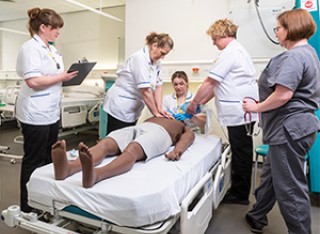
Dr Sarah L Trinder
About
Biography
Sarah is the Associate Head of School - Education for the School of Biosciences and Senior Lecturer in Pharmacology. She is the former Programme Director for BSc Biochemistry and played a key role in the design of the MSci Biochemistry curriculum. Additionally, Sarah is an external examiner at Imperial College, London and an Honorary Lecturer at University College London (UCL). She teaches across the Biosciences at both undergraduate and postgraduate levels.
Prior to joining Surrey, her research centred around pulmonary hypertension and connective tissue diseases. This research considered the remodelling aspects of these conditions using both in vitro and pre-clinical models.
University roles and responsibilities
- Associate Head of School - Education - School of Biosciences
Previous roles
Affiliations and memberships
News
Publications
NKX2-5 is a member of the homeobox-containing transcription factors critical in regulating tissue differentiation in development. Here, we report a role for NKX2-5 in vascular smooth muscle cell phenotypic modulation in vitro and in vascular remodeling in vivo. NKX2-5 is upregulated in scleroderma patients with pulmonary arterial hypertension. Suppression of NKX2-5 expression in smooth muscle cells halted vascular smooth muscle proliferation and migration, enhanced contractility, and blocked the expression of extracellular matrix genes. Conversely, overexpression of NKX2-5 suppressed the expression of contractile genes (ACTA2, TAGLN, CNN1) and enhanced the expression of matrix genes (COL1) in vascular smooth muscle cells. In vivo, conditional deletion of NKX2-5 attenuated blood vessel remodeling and halted the progression to hypertension in a mouse chronic hypoxia model. This study revealed that signals related to injury such as serum and low confluence, which induce NKX2-5 expression in cultured cells, is potentiated by TGF-β and further enhanced by hypoxia. The effect of TGF-β was sensitive to ERK5 and PI3K inhibition. Our data suggest a pivotal role for NKX2-5 in the phenotypic modulation of smooth muscle cells during pathological vascular remodeling and provide proof of concept for therapeutic targeting of NKX2-5 in vasculopathies.
Connective tissue growth factor (CTGF, CCN2) is a matricellular protein which plays key roles in normal mammalian development and in tissue homeostasis and repair. In pathological conditions, dysregulated CCN2 has been associated with cancer, cardiovascular disease, and tissue fibrosis. In this study, genetic manipulation of the CCN2 gene was employed to investigate the role of CCN2 expression in vitro and in experimentally-induced models of pulmonary fibrosis and pulmonary arterial hypertension (PAH). Knocking down CCN2 using siRNA reduced expression of pro-fibrotic markers (fibronectin p < 0.01, collagen type I p < 0.05, ?-SMA p < 0.0001, TIMP-1 p < 0.05 and IL-6 p < 0.05) in TGF-?-treated lung fibroblasts derived from systemic sclerosis patients. In vivo studies were performed in mice using a conditional gene deletion strategy targeting CCN2 in a fibroblastspecific and time-dependent manner in two models of lung disease. CCN2 deletion significantly reduced pulmonary interstitial scarring and fibrosis following bleomycin-instillation, as assessed by fibrotic scores (wildtype bleomycin 3.733 ? 0.2667 vs CCN2 knockout (KO) bleomycin 4.917 ? 0.3436, p < 0.05) and micro-CT. In the well-established chronic hypoxia/Sugen model of pulmonary hypertension, CCN2 gene deletion resulted in a significant decrease in pulmonary vessel remodelling, less right ventricular hypertrophy and a reduction in the haemodynamic measurements characteristic of PAH (RVSP and RV/LV + S were significantly reduced (p < 0.05) in CCN2 KO compared to WT mice in hypoxic/SU5416 conditions). These results support a prominent role for CCN2 in pulmonary fibrosis and in vessel remodelling associated with PAH. Therefore, therapeutics aimed at blocking CCN2 function are likely to benefit several forms of severe lung disease.
Background: Pulmonary arterial hypertension (PAH) is an important complication of SSc that occurs in around 10% of cases. We have previously shown that a TGFb dependent transgenic mouse strain (TbRIIk-fib) is susceptible to organ based pathology relevant to SSc including development of pulmonary hypertension (PH) after pharmacological pulmonary endothelial injury by SU5416, a VEGF receptor inhibitor. In this study, we have prevented the development of PH in this mouse strain using macitentan, a novel dual ETA/B receptor antagonist recently licensed to treat PAH in CTD based upon a significant effect on morbidity and mortality in PAH. Methods: SU5416, a VEGF receptor inhibitor, was administered to all TbRIIk-fib transgenic (TG) mice and wild-type (WT) littermate controls to induce endothelial injury with subsequent endothelial proliferation and PH in transgenic mice only. Mice were treated with either 50 mg/kg macitentan daily by oral gavage or vehicle alone (n ¼ 8 for each group) either before SU5416 injection or on day 8 following injection. The development of PH in each group was assessed by histology and immunohistochemistry of vessel architecture, in vivo haemodynamic studies and RV mass index measurements. Biochemical responses to TGFb, endothelin and VEGF stimulation before and after macitentan were examined in cultured T bRII k-fib lung fibroblasts. Results: Compared with WT littermates, after SU5416, all TG mice developed a prominent perivascular chronic inflammatory infiltrate and smooth muscle layer hypertrophy, as previously described. RV mass index was elevated in TG animals receiving vehicle compared with other groups (TG vehicle 0.29 0.007, TG macitentan 0.24 0.007, P < 0.05). The increase in RV systolic pressure in TG animals treated with SU5416 was also abrogated by macitentan (TG vehicle 28.8 mmHg 0.72, TG macitentan 22.0 1.62, P < 0.001) without any significant change in systemic arterial blood pressure in any group. Treatment with macitentan after day 8 was sufficient to normalize haemodynamic consequences of SU5416 administration. There was obliterative pulmonary arteriolar occlusion in 21% of vessels in TG mice treated with vehicle. In contrast, no vessels in WT mice or TG mice treated with macitentan developed this histological change. Explanted TG lung fibroblasts showed an increase in proliferation and migration with upregulation of VEGF and TGFb signalling and downregulation of endothelin receptor A compared with WT littermates. Conclusion: Macitentan prevents the development of histological and haemodynamic PH in this mouse model of SSc. These findings suggest a pivotal role for perturbed endothelin activity in the development of PH associated with altered TGFb and VEGF signalling. Our results also validate this model as a platform for experimental therapeutic studies and provide further insight into pathogenic mechanisms of PAH in SSc.
RATIONALE: Up to 10% of patients with systemic sclerosis (SSc) develop pulmonary arterial hypertension (PAH). This risk persists throughout the disease and is time dependent, suggesting that SSc is a susceptibility factor. Outcome for SSc-PAH is poor compared with heritable or idiopathic forms, despite clinical and pathological similarities. Although susceptibility in heritable PAH and idiopathic PAH is strongly associated with gene mutations leading to reduced expression of bone morphogenetic protein receptor (BMPR) II, these mutations have not been observed in SSc-PAH. OBJECTIVES: To explore BMPRII expression and function in a mouse model of SSc (TβRIIΔk-fib) that is susceptible to developing pulmonary hypertension and in SSc lung. METHODS: BMPRII and downstream signaling pathways were profiled in lung tissue and fibroblasts from the TβRIIΔk-fib model, which develops pulmonary vasculopathy with pulmonary hypertension that is exacerbated by SU5416. Complementary studies examined SSc or control lung tissue and fibroblasts. MEASUREMENTS AND MAIN RESULTS: Our study shows reduced BMPRII, impaired signaling, and altered receptor turnover activity in a transforming growth factor (TGF)-β-dependent mouse model of SSc-PAH. Similarly, a significant reduction in BMPRII expression is observed in SSc lung tissue and fibroblasts. Increased proteasomal degradation of BMPRII appears to underlie this and may result from heightened TGF-β activity. CONCLUSIONS: We found reduced BMPRII protein in patients with SSc-PAH and a relevant mouse model associated with increased proteasomal degradation of BMPRII. Collectively, these results suggest that impaired BMP signaling, resulting from TGF-β-dependent increased receptor degradation, may promote PAH susceptibility in SSc and provide a unifying mechanism across different forms of PAH.
OBJECTIVE: To delineate the constitutive pulmonary vascular phenotype of the TβRIIΔk-fib mouse model of scleroderma, and to selectively induce pulmonary endothelial cell injury using vascular endothelial growth factor (VEGF) inhibition to develop a model with features characteristic of pulmonary arterial hypertension (PAH). METHODS: The TβRIIΔk-fib mouse strain expresses a kinase-deficient transforming growth factor β (TGFβ) receptor type II driven by a fibroblast-specific promoter, leading to ligand-dependent up-regulation of TGFβ signaling, and replicates key fibrotic features of scleroderma. Structural, biochemical, and functional assessments of pulmonary vessels, including in vivo hemodynamic studies, were performed before and following VEGF inhibition, which induced pulmonary endothelial cell apoptosis. These assessments included biochemical analysis of the TGFβ and VEGF signaling axes in tissue sections and explanted smooth muscle cells. RESULTS: In the TβRIIΔk-fib mouse strain, a constitutive pulmonary vasculopathy with medial thickening, a perivascular proliferating chronic inflammatory cell infiltrate, and mildly elevated pulmonary artery pressure resembled the well-described chronic hypoxia model of pulmonary hypertension. Following administration of SU5416, the pulmonary vascular phenotype was more florid, with pulmonary arteriolar luminal obliteration by apoptosis-resistant proliferating endothelial cells. These changes resulted in right ventricular hypertrophy, confirming hemodynamically significant PAH. Altered expression of TGFβ and VEGF ligand and receptor was consistent with a scleroderma phenotype. CONCLUSION: In this study, we replicated key features of systemic sclerosis-related PAH in a mouse model. Our results suggest that pulmonary endothelial cell injury in a genetically susceptible mouse strain triggers this complication and support the underlying role of functional interplay between TGFβ and VEGF, which provides insight into the pathogenesis of this disease.
Background/Purpose: Pulmonary arterial hypertension (PAH) is an important complication of systemic sclerosis (SSc) that occurs in around 10% of cases. We have previously shown that a TGFbeta dependent transgenic mouse strain (TβRIIΔk-fib) is susceptible to organ based pathology relevant to SSc and that pulmonary endothelial injury is associated with development of PH with perturbed VEGF, BMP and endothelin signalling. In this study, we have prevented the development of PH in this mouse strain using macitentan, a potent endothelin receptor antagonist recently licensed to treat PAH in connective tissue disease based upon a significant effect on morbidity and mortality in PAH. Methods: SU5416, a VEGF receptor inhibitor, was administered to all TβRIIΔk-fib transgenic (TG) mice and littermate wildtype (WT) animals to induce endothelial injury with subsequent endoluminal proliferation and PH in transgenic mice only. Mice were treated with either 50mg/kg macitentan daily by oral gavage or vehicle alone (n=8 each group). The development of PH in each group was assessed by histology and immunohistochemistry of vessel architecture, in vivo haemodynamic studies and RV mass index measurements. Results: Compared with WT littermates, after SU5416, all TG mice developed a prominent perivascular chronic inflammatory infiltrate and smooth muscle layer hypertrophy, as previously described. RV mass index was elevated in TG animals receiving vehicle compared to other groups (TG vehicle 0.29±0.007, TG macitentan 0.24±0.007, p
Purpose Concept maps have been described as a valuable tool for exploring curriculum knowledge. However, less attention has been given to the use of them to visualise contested and tacit knowledge, i.e. the values and perceptions of teachers that underpin their practice. This paper aims to explore the use of concept mapping to uncover academics’ views and help them articulate their perspectives within the framework provided by the concepts of pedagogic frailty and resilience in a collaborative environment. Design/methodology/approach Participants were a group of five colleagues within a Biochemical Science Department, working on the development of a new undergraduate curriculum. A qualitative single-case study was conducted to get some insights on how concept mapping might scaffold each step of the collaborative process. They answered the online questionnaire; their answers were “translated” into an initial expert-constructed concept map, which was offered as a starting point to articulate their views during a group session, resulting in a consensus map. Findings Engaging with the questionnaire was useful for providing the participants with an example of an “excellent” map, sensitising them to the core concepts and the possible links between them, without imposing a high level of cognitive load. This fostered dialogue of complex ideas, introducing the potential benefits of consensus maps in team-based projects. Originality/value An online questionnaire may facilitate the application of the pedagogic frailty model for academic development by scaling up the mapping process. The map-mediated facilitation of dialogue within teams of academics may facilitate faculty development by making explicit the underpinning values held by team members.
In this case study, we discuss a Framework for Higher Education Qualifications (FHEQ) level 7 module, Developing as a Biochemist: Effectively Communicating Science in Modern Society, which forms a key part in the educational development of students in the final year of an MSci in Biochemistry at the University of Surrey. In this skills-based and student-centred module, students work to develop familiarity and competency across a broad range of communications platforms. A dynamic assessment approach enabled the provision of an active peer-feedback and peer-review process. The cyclical provision of feedback and review, coupled with the application of a greater level of feedback literacy, empowered students’ development of critical employability skills. We will discuss the background to this approach, the perceived effectiveness of the peer-review and peer-feedback process, from both teacher and learner perspectives, and will provide some considerations for implementing similar interventions in practice.
Background: SSc is a complex autoimmune fibrotic disease, characterized by elevated deposition of extracellular matrix (ECM) proteins, in particular collagen type I. The disease is heterogeneous; organs commonly affected by fibrosis are the skin, kidney, lung and heart. Vascular complications include pulmonary arterial hypertension (PAH), which occurs in 12–40% of patients. CD14þmonocytes are afunctionally heterogeneous cell type. They have been noted to differentiate into a number of cell phenotypes including macrophages and collagen-producing fibrocytes. In culture fibrocytes adopt a spindle shape, co-express haematopoietic CD45RO and 25F9, along with mesenchymal markers including aSMA and collagen type I. Fibrocytes amplify the inflammatory/immune response through distinct mechanisms, including antigen presentation, cytokine and chemokine secretion, and the production of MMPs. We and others have shown fibrocyte differentiation is enhanced by fibrogenic cytokines including PDGF. Here we seek to understand the mechanism by which SSc fibrocytes influence the local microenvironment of the tissue. Methods: CD14þ peripheral blood mononuclear cells (PBMCs) were isolated from SSc patient and healthy control blood. PBMCs were cultured in the presence of macrophage colony stimulating factor (MCSF; n > 10) and/or endothelin-1 (ET-1; n > 10); after 14 days of culture number of fibrocytes was assessed. The effect of pharmacological inhibitors including ETRA and ETRB antagonism on fibrocyte differentiation (n ¼ 6 SSc and control) was investigated. Secreted factors in culture media from SSc and control fibrocytes were assessed by ELISA (n ¼ 6), and the effects of conditioned media explored in 3D-collagen gel. Results: Both MCSF and ET-1 significantly induced fibrocyte differentiation, in combination differentiation was significantly augmented (P < 0.05) in comparison with mono-treatment. SSc fibrocytes more readily differentiated from CD14þ PBMCs than healthy control donors in response to MCSF (P < 0.05), ET-1 (P < 0.05) as well as MCSF with ET-1 in combination (P < 0.01). ETRA and ETRB antagonists, BQ123 and BQ788 (respectively), and Bosentan (a dual ETR antagonist) inhibited MCSF induced fibrocyte differentiation in a concentration dependant manner. Furthermore SSc fibrocytes secreted significantly more connective tissue growth factor (CTGF) than control fibrocytes (P < 0.05) cultured with MCSF. Consistent with fibrocytes acting in a paracrine manner, conditioned media from SSc fibrocytes promoted fibroblast gel contraction by control cells (P < 0.05). Conclusion: Here we show CD14þ SSc PBMCs more readily differentiate into fibrocytes and that activation via the ETRA and ETRB is essential for ET-1 and MCSF induced fibrocyte differentiation. Suggesting MCSF acts indirectly via ET-1 release; possibly resulting in a positive feedback loop. Our data suggest fibrocytes may contribute to the development of a pro-fibrotic environment through influencing tissue resident fibroblasts in a paracrine manner
Platelets are a recognised potent source of Transforming Growth Factor-1 (TGF1), a cytokine known to promote wound healingand regenerationby stimulating dermal fibroblast proliferation and extracellular matrix deposition. Platelet lysate has been advocated as a novel personalised therapeutic to treat persistent wounds, although the precise platelet-derived growth factors responsible for these beneficial effects have not been fully elucidated. The aim of thisstudy was to investigate the specific role of platelet-derived TGF1in cutaneous wound healing.Using a transgenic mouse with a targeted deletion of TGF1in megakaryocytes and platelets (TGFβ1fl/fl.PF4-Cre), we show for the first-time platelet-derived TGF1 contributes to epidermal and dermal thickening and cellular turnover after excisional skin wounding. In vitrostudies demonstrate human dermal fibroblasts stimulated with platelet lysate containing high levels of platelet-derived TGF1 did not exhibit enhanced collagen deposition or proliferation, suggestingthat platelet-derived TGF1 is not a key promoter of these wound healing processes.Interestingly, human keratinocytes displayed enhanced TGF1-driven proliferation in response to platelet lysate, reminiscent of our in vivofindings. In summary, our novel findings define andemphasiseanimportant roleof platelet-derived TGF1in epidermal remodellingand regenerationprocessesduring cutaneous wound healing.
Abstract Abstract Vascular complications associated with systemic sclerosis (SSc) including pulmonary arterial hypertension (PAH-SSc), result from endothelial damage and loss of barrier function. Endothelial progenitor cells (EPCs) express endothelial (VEGFR2+, CD31+ ) and haematopoietic (CD133+ ) markers. They home to sites of vascular injury and differentiate into endothelial cells restoring the endothelium. In SSc patients circulating levels of EPCs are reduced. This study aimed to develop a robust method to grow EPCs from peripheral blood mononuclear cells (PBMCs) and to compare cellular functions to mature endothelial cells. Methods EPCs and human pulmonary artery endothelial cells (hPAECs) were seeded into transwell inserts and grown to confluence. Cells were incubated with TNFa (50ng/ml), and their capacity to form biological barriers assessed using FITC-albumin (5mg/ml). FITC-albumin ‘leak’ was quantified by fluorescent absorbance over time. We further assessed the responses of EPCs to TNFa stimulation by ELISA to quantify pro-inflammatory cytokine release. Results EPCs form a biological exclusion barrier with similar capabilities as mature hPAECs. TNFa significantly enhanced the permeability of EPCs (P < 0.05) and hPAECs (P < 0.05) monolayers. There is no difference in EPC colony formation between HC and SSc EPCs. Discussion We developed a robust method for isolating EPCs from PBMCs. We have demonstrated that EPCs can maintain an endothelial barrier consistent with that observed by mature hPAECs in vitro. We have established that EPCs respond to TNFa in a similar manner to mature PAECs. We have shown no significant difference in the capacity of PBMCs from SSc patients to form EPC colonies compared to HCs.
Introduction Scleroderma (SSc) is an autoimmune connective tissue disease of unknown aetiology. Pulmonary involvement including the development of pulmonary arterial hypertension (PAH) is characterised by vascular remodelling, collagen deposition and expression of connective tissue growth factor (CTGF). CD14+ monocytes can differentiate into spindle shaped cells termed ‘fibrocytes’. Fibrocytes express haematopoietic and mesenchymal markers including collagen, and amplify inflammatory/immune responses via antigen presentation and chemokine secretion. Fibrocyte differentiation is enhanced by fibrogenic cytokines including PDGF. The role fibrocytes play in promoting PAH in SSc is unknown. Methods CD14+ PBMCs were isolated from SSc and healthy donor blood. Fibrocyte differentiation in the presence of MCSF and/or ET-1 was assessed after 14 days. The effect of endothelin receptor (ETR) antagonists (selective/dual) on fibrocyte differentiation (n = 6) was investigated. SSc and control fibrocyte secretomes were assessed by ELISA (n = 6), and the effects on fibroblast-mediated gel contraction determined. Results MCSF and ET-1 alone and in combination induced fibrocyte differentiation (P < 0.05). SSc fibrocytes exhibited enhanced differentiation from CD14+ PBMCs than healthy control donors in response to MCSF (P < 0.05), ET-1 (P < 0.05) and in combination (P < 0.01). ETR antagonists BQ123 (ETRA), BQ788 (ETRB) and Bosentan (ETRA/B) inhibited MCSF induced fibrocyte differentiation. CTGF secretion was elevated in SSc compared to control fibrocytes (P < 0.05) cultured with MCSF. Conditioned media from SSc fibrocytes promoted gel contraction by control pulmonary fibroblasts (P < 0.05). Discussion CD14+ SSc PBMCs readily differentiate into fibrocytes in response to ET-1 and MCSF via ETRA and ETRB. Our data suggests fibrocytes contribute to the development of PAH in SSc via a paracrine mechanism modulating the functional activities of resident tissue fibroblasts.
BACKGROUND: Pulmonary hypertension (PH) is a life-threatening disorder characterized by increased pulmonary artery pressure, remodeling of the pulmonary vasculature, and right ventricular failure. Loss of endothelium-derived nitric oxide (NO) and prostacyclin contributes to PH pathogenesis, and current therapies are targeted to restore these pathways. Phosphodiesterases (PDEs) are a family of enzymes that break down cGMP and cAMP, which underpin the bioactivity of NO and prostacyclin. PDE5 inhibitors (eg, sildenafil) are licensed for PH, but a role for PDE2 in lung physiology and disease has yet to be established. Herein, we investigated whether PDE2 inhibition modulates pulmonary cyclic nucleotide signaling and ameliorates experimental PH. METHODS AND RESULTS: The selective PDE2 inhibitor BAY 60-7550 augmented atrial natriuretic peptide- and treprostinil-evoked pulmonary vascular relaxation in isolated arteries from chronically hypoxic rats. BAY 60-7550 prevented the onset of both hypoxia- and bleomycin-induced PH and produced a significantly greater reduction in disease severity when given in combination with a neutral endopeptidase inhibitor (enhances endogenous natriuretic peptides), trepostinil, inorganic nitrate (NO donor), or a PDE5 inhibitor. Proliferation of pulmonary artery smooth muscle cells from patients with pulmonary arterial hypertension was reduced by BAY 60-7550, an effect further enhanced in the presence of atrial natriuretic peptide, NO, and treprostinil. CONCLUSIONS: PDE2 inhibition elicits pulmonary dilation, prevents pulmonary vascular remodeling, and reduces the right ventricular hypertrophy characteristic of PH. This favorable pharmacodynamic profile is dependent on natriuretic peptide bioactivity and is additive with prostacyclin analogues, PDE5 inhibitor, and NO. PDE2 inhibition represents a viable, orally active therapy for PH.
Background The development of pulmonary arterial hypertension in scleroderma remains an important contributor to mortality in this condition, despite substantial improvements in outcomes due to modern therapeutic strategies. No animal models of scleroderma develop this important complication. We describe the constitutive vascular phenotype of a mouse model of scleroderma and show that pulmonary endothelial injury replicates the pathological changes of pulmonary arterial hypertension seen in human disease. Methods The TβRIIΔk-fib mouse strain expresses a kinase-deficient type II transforming growth factor β (TGFβ) receptor driven by a fibroblast-specific promoter leading to ligand-dependent upregulation of TGFβ signalling; this mouse strain replicates key fibrotic features of scleroderma. We did structural, biochemical, and functional assessments of pulmonary and systemic vessels, including in-vivo haemodynamic studies, before and after vascular endothelial growth factor receptor (VEGFR) inhibition with SU5416, which induced pulmonary endothelial cell apoptosis. These assessments included biochemical analysis of the TGFβ, endothelin, and VEGF signalling axes in vivo; tissue sections; and explanted pulmonary arterial smooth muscle cells. Findings In the TβRIIΔk-fib mouse strain, a constitutive pulmonary vasculopathy with medial thickening, a perivascular proliferating chronic inflammatory cell infiltrate, and mildly raised pulmonary artery pressures resemble the well-described chronic hypoxia model of pulmonary hypertension. After administration of SU5416, the pulmonary vascular phenotype was more florid, with pulmonary arteriolar luminal obliteration by apoptosis-resistant proliferating endothelial cells; the result was right ventricular hypertrophy confirming haemodynamically significant pulmonary arterial hypertension. Altered TGFβ, endothelin, and ligand and receptor expression of VEGF were consistent with a scleroderma phenotype. Interpretation This study replicates key features of scleroderma-associated pulmonary arterial hypertension in a mouse model. Our results suggest that pulmonary endothelial cell injury in a genetically susceptible mouse strain triggers this complication and support functional interplay between TGFβ, endothelin, and VEGF that provides insight into pathogenesis.
When developing meaningful curricula, institutions must engage with the desired disciplinary attributes of their graduates. Successfully employed in several areas, including psychology and chemistry, disciplinary literacies provide structure for the development of core competencies‐pursuing progressive education. To this end, we have sought to develop a comprehensive blueprint of a graduate biochemist, providing detailed insight into the development of skills in the context of disciplinary knowledge. The Biochemical Literacy Framework (BCLF) aspires to encourage innovative course design in both the biochemical field and beyond through stimulating discussion among individuals developing undergraduate biochemistry degree courses based on pedagogical best practice. Here, we examine the concept of biochemical literacy aiming to start answering the question: What must individuals do and know to approach and transform ideas in the context of the biochemical sciences? The BCLF began with the guidance published by relevant learned societies – including the Royal Society of Biology, the Biochemical Society, the American Society for Biochemistry and Molecular Biology and the Quality Assurance Agency, before considering relevant pedagogical literature. We propose that biochemical literacy is comprised of seven key skills: critical thinking, self‐management, communication, information literacy, visual literacy, practical skills and content knowledge. Together, these form a dynamic, highly interconnected and interrelated meta‐literacy supporting the use of evidence‐based, robust learning techniques. The BCLF is intended to form the foundation for discussion between colleagues, in addition to forming the groundwork for both pragmatic and exploratory future studies into facilitating and further defining biochemical literacy.
Background/Purpose: Systemic sclerosis (SSc) is a complex pro-inflammatory scarring disease, characterised by elevated deposition of extracellular matrix (ECM) proteins, in particular collagen type I. The disease is heterogeneous affecting both the skin and visceral organs including kidney, lung and heart. The SSc fibroblast is a key cell which promotes a pro-inflammatory and fibrotic microenvironment that can lead to the loss of normal tissue architecture and organ function. The mechanisms that contribute to the formation and persistence of the SSc dermal fibroblast remain unclear. We have previously shown the epigenetic bromodomain and extra-terminal domain-containing proteins (Brd) which bind to acetylated histone residues, play a significant role in pulmonary fibrosis. Here we seek to explore the contribution of Brd proteins in the development of dermal fibrosis using a specific inhibitor of Brd proteins (Brd 2, 3, 4 and T), JQ1. Methods: We investigated the dose-response of JQ1 on SSc and healthy control (HC) donor (n≥3) dermal fibroblasts. We assessed the effects on collagen deposition and processing using the Scar-in-a-Jar in vitrofibrosis assay, by western blot and immuno-florescence microscopy for collagen type I (n=4). To determine the effect of JQ1 in a pre-clinical model of skin fibrosis, female C57BL/6 mice were given three weekly subcutaneous injections of 100µl sterile saline (n≥6) or 0.1U/ml bleomycin (n≥6) for 14 days and treated with 12mg/kg/day JQ1 (n≥6) or vehicle (n≥6). After 14 days histological analysis for fibrogenic proteins and ECM was performed on skin, and pro-inflammatory chemokines in sera assessed by ELISA. Results: IL-6 and MCP-1 secretion by SSc and HC donor fibroblasts was significantly (P
BACKGROUND: Pulmonary hypertension (PH) is a multifactorial disease characterized by increased pulmonary vascular resistance and right ventricular failure; morbidity and mortality remain unacceptably high. Loss of nitric oxide (NO) bioactivity is thought to contribute to the pathogenesis of PH, and agents that augment pulmonary NO signaling are clinically effective in the disease. Inorganic nitrate (NO(3)(-)) and nitrite (NO(2)(-)) elicit a reduction in systemic blood pressure in healthy individuals; this effect is underpinned by endogenous and sequential reduction to NO. Herein, we determined whether dietary nitrate and nitrite might be preferentially reduced to NO by the hypoxia associated with PH, and thereby offer a convenient, inexpensive method of supplementing NO functionality to reduce disease severity. METHODS AND RESULTS: Dietary nitrate reduced the right ventricular pressure and hypertrophy, and pulmonary vascular remodeling in wild-type mice exposed to 3 weeks of hypoxia; this beneficial activity was mirrored largely by dietary nitrite. The cytoprotective effects of dietary nitrate were associated with increased plasma and lung concentrations of nitrite and cGMP. The beneficial effects of dietary nitrate and nitrite were reduced in mice lacking endothelial NO synthase or treated with the xanthine oxidoreductase inhibitor allopurinol. CONCLUSIONS: These data demonstrate that dietary nitrate, and to a lesser extent dietary nitrite, elicit pulmonary dilatation, prevent pulmonary vascular remodeling, and reduce the right ventricular hypertrophy characteristic of PH. This favorable pharmacodynamic profile depends on endothelial NO synthase and xanthine oxidoreductase -catalyzed reduction of nitrite to NO. Exploitation of this mechanism (ie, dietary nitrate/nitrite supplementation) represents a viable, orally active therapy for PH.
Introduction. Vascular complications associated with systemic sclerosis (SSc) including pulmonary arterial hypertension (PAH-SSc), result from endothelial damage and loss of barrier function. The causes of endothelial dysfunction are unclear, but the integrity of the endothelium is likely to be significantly diminished in SSc. Endothelial progenitor cells (EPCs) derived from peripheral blood mononuclear cells (PBMCs) express endothelial and haematopoietic markers. It is thought they home to sites of vascular injury and differentiate into endothelial cells and restore the barrier. In SSc patients circulating levels of EPCs are reduced. This study aimed to: (i) develop a robust method to isolate and grow healthy control (HC) and SSc EPCs from PBMCs. (ii) Compare the cellular functions of EPCs to mature endothelial cells. Methods. Peripheral blood was taken from HC (n=10) and SSc donors (n=10). EPCs were cultured from PBMCs, and EPC colonies grown to passage 4. EPCs and human pulmonary artery endothelial cells (hPAECs) were seeded into transwell inserts and grown to confluence. Cells were incubated with TNF-α (10ng/ S-33 3rd Systemic Sclerosis World Congress Poster Tours - Clinical ml), and their capacity to form biological barriers and support immune cell influx was assessed using FITC-albumin (0.5mg/ml) and neutrophil transmigration. We further assessed the responses of EPCs to TNF-α stimulation by ELISA to quantify pro-inflammatory cytokine release. Results. We demonstrate that EPCs form biological barriers with similar capabilities as mature hPAECs in vitro. TNF-α significantly enhanced permeability of EPCs (p
BACKGROUND AND PURPOSE: Idiopathic pulmonary fibrosis (IPF) is a progressive fibro-proliferative disorder refractory to current therapy commonly complicated by the development of pulmonary hypertension (PH); the associated morbidity and mortality are substantial. Natriuretic peptides possess vasodilator and anti-fibrotic actions, and pharmacological augmentation of their bioactivity ameliorates renal and myocardial fibrosis. Here, we investigated whether natriuretic peptides possess an intrinsic cytoprotective function preventing the development of pulmonary fibrosis and associated PH, and whether therapeutics targeting natriuretic peptide signalling demonstrate efficacy in this life-threatening disorder. EXPERIMENTAL APPROACH: Pulmonary haemodynamics, right ventricular function and markers of lung fibrosis were determined in wild-type (WT) and natriuretic peptide receptor (NPR)-A knockout (KO) mice exposed to bleomycin (1 mg·kg(-1) ). Human myofibroblast differentiation was studied in vitro. KEY RESULTS: Exacerbated cardiac, vascular and fibrotic pathology was observed in NPR-A KO animals, compared with WT mice, exposed to bleomycin. Treatment with a drug combination that raised circulating natriuretic peptide levels (ecadotril) and potentiated natriuretic peptide-dependent signalling (sildenafil) reduced indices of disease progression, whether administered prophylactically or to animals with established lung disease. This positive pharmacodynamic effect was diminished in NPR-A KO mice. Atrial natriuretic peptide and sildenafil synergistically reduced TGFβ-induced human myofibroblast differentiation, a key driver of remodelling in IPF patients. CONCLUSIONS AND IMPLICATIONS: These data highlight an endogenous host-defence capacity of natriuretic peptides in lung fibrosis and PH. A combination of ecadotril and sildenafil reversed the pulmonary haemodynamic aberrations and remodelling that characterize the disease, advocating therapeutic manipulation of natriuretic peptide bioactivity in patients with IPF.
Background/Purpose: Vascular complications are a key pathological feature of systemic sclerosis (SSc) affecting the microcirculation and arterioles. Under normal circumstances the endothelium acts as a biological barrier supporting controlled permeability, immune surveillance and cellular trafficking. In SSc endothelial damage, contributes to barrier dysfunction and elevated immune cell infiltration and inflammation. The cause(s) of the initial endothelial dysfunction in SSc is unclear. Blood outgrowth endothelial cells (BOECs) are thought to home to sites of vascular injury and differentiate into endothelial cells, aiding the repair and restoration of normal endothelial functions. Circulating levels of BOECs have been shown to be reduced in SSc patients, and recent studies suggest that BOECs may be dysfunctional in vascular diseases. Here we sought to assess SSc-BOECs and their contribution to vascular dysfunction in SSc. Methods: BOECs were established from peripheral blood PBMCs from healthy donors (HD) and SSc patients. BOECs from HD (n=5) and SSc patients (n=6) were profiled using Illumina HT12 gene arrays and secreted inflammatory cytokines profiled by meso discovery scale (MSD) arrays. The capacity of SSc-BOECs (n=4) and HD-BOECs (n=4) to: 1) Establish biological barriers alone or in co-culture with mature endothelial cells, was assessed using electric cell-substrate impedance sensing (ECIS); 2) Support PBMC (n=4) trans-endothelial migration, by forming monolayers in 24-well transwell inserts stimulated with or without TNFα (10ng/ml). Results: Using gene set enrichment analysis, it was determined that SSc-BOECs exhibit a significantly altered gene expression profile including inflammatory chemokines and cytokines. In addition SSc-BOECs exhibited significantly elevated pro-inflammatory cytokine secretion compared to HD-BOECs, including IL-6 (P
Background/Purpose Vascular complications in Scleroderma (SSc) patients are associated with high mortality, particularly in patients who develop pulmonary arterial hypertension (SSc-PAH). Vascular complications, thought to arise from initial activation and dysfunction of the endothelium can lead to: elevated vascular leak, inflammation, mesenchymal hypertrophy by activation of resident smooth muscle cells and fibroblasts, and neointima formation. Recent studies suggest that as well as resident mesenchymal cells, endothelial cells can undergo endothelial-mesenchymal transition (EndoMT), and acquire a mesenchymal phenotype which may contribute to the expansion of the mesenchymal cell population. Here we sought to determine the prevalence of EndoMT in SSc-PAH patients and pre-clinical models of PAH, and assess the cellular effects on pulmonary artery endothelial cells (PAECs) functions. Methods Using lung tissue from SSc-PAH patients (n=3), healthy control (HC) donors (n=3), and from the hypoxia/SU5416 pre-clinical murine model of PAH (n=5), EndoMT was determined by immunofluorescence based on co-expression of vWF and αSMA. EndoMT was induced in human PAECs (n=3) in vitro by TNFα [5ng/ml], IL-1β [0.1ng/m;] and TGFβ [5ng/ml] in combination. Morphological changes were assessed by light microscopy and phalloidin staining. Western blotting and immunofluorescence was used to quantify: CD31, vWF, occludin, VE-cadherin, αSMA, calponin and collagen type 1 expression. Conditioned media was collected from PAECs, PAECs following treatment to initiate EndoMT and SSc-PAH and HC fibroblasts; levels of inflammatory secretion was quantified by MSD arrays. The capacity of homogenous EndoMT monolayers (n=6) and mixed cultures of 1:10 EndoMT:PAECs (n=6) cells to form exclusion barriers was assessed using trans-well permeability FITC-albumin assays. Results Co-localisation of vWF and αSMA was observed in ≤5% of pulmonary arteries from SSc-PAH patients and hypoxia/SU5416 mice. PAECs treated with TNFα, IL-1β and TGFβ exhibited significant changes in morphology, loss of endothelial markers and elevated expression of mesenchymal markers by day 6. There was a significant (P0.01) 5-fold increase in permeability compared to PAECs alone. Consistent with this, EndoMT cells co-cultured with PAECs in a ratio of 1:10 led to 2.5-fold significant (P>0.05) increase in permeability. Conclusion The co-localisation of vWF and αSMA present in the pulmonary arteries of SSc-PAH patients and pre-clinical models of PAH, is indicative of EndoMT. We demonstrate EndoMT leads to a loss of normal PAEC morphology and an enhanced secretion of pro-inflammatory chemokines. Furthermore EndoMT cells failed to form integral biological barriers and contributed to enhanced permeability of PAEC barriers. Collectively our data suggests that EndoMT may contribute to the loss of normal endothelium function and the development of SSc-PAH.
Pulmonary arterial hypertension (PAH) is a progressive disease characterized by lung endothelial cell dysfunction and vascular remodeling. Normally, the endothelium forms an integral cellular barrier to regulate vascular homeostasis. During embryogenesis endothelial cells exhibit substantial plasticity that contribute to cardiac development by undergoing endothelial-to-mesenchymal transition (EndoMT). We determined the presence of EndoMT in the pulmonary vasculature in vivo and the functional effects on pulmonary artery endothelial cells (PAECs) undergoing EndoMT in vitro. Histologic assessment of patients with systemic sclerosis-associated PAH and the hypoxia/SU5416 mouse model identified the presence von Willebrand factor/α-smooth muscle actin-positive endothelial cells in up to 5% of pulmonary vessels. Induced EndoMT in PAECs by inflammatory cytokines IL-1β, tumor necrosis factor α, and transforming growth factor β led to actin cytoskeleton reorganization and the development of a mesenchymal morphology. Induced EndoMT cells exhibited up-regulation of mesenchymal markers, including collagen type I and α-smooth muscle actin, and a reduction in endothelial cell and junctional proteins, including von Willebrand factor, CD31, occludin, and vascular endothelial-cadherin. Induced EndoMT monolayers failed to form viable biological barriers and induced enhanced leak in co-culture with PAECs. Induced EndoMT cells secreted significantly elevated proinflammatory cytokines, including IL-6, IL-8, and tumor necrosis factor α, and supported higher immune transendothelial migration compared with PAECs. These findings suggest that EndoMT may contribute to the development of PAH.




